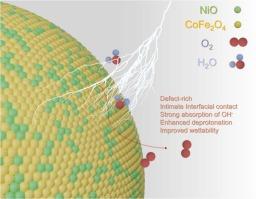亲氧工程原位构建NiO/CoFe2O4异质结高效水氧化
IF 6.3
2区 材料科学
Q2 CHEMISTRY, PHYSICAL
引用次数: 0
摘要
原位构建异质结是实现密切界面接触的有效途径,通过优化各组分之间的界面电子结构,加速了析氧反应动力学。在此,我们提出了一种简单的方法,利用Ni作为低亲氧掺杂剂诱导氧缺陷物质的产生,使NiO在CoFe2O4上原位生长,从而制备了一种新的NiO/CoFe2O4 (NiO/CFO)异质结。异质结构的产生触发了界面处的电子调制,从而促进了OER过程中含氧中间体的吸附和解离。因此,NiO/CFO电极需要270 mV的低过电位才能在1 mol KOH中提供10 mA cm-2的电流密度。此外,由NiO/CFO和20% Pt/C组装的水分解系统已经成功构建,在10 mA cm-2下显示出1.555 V的电位。本工作在一定程度上为原位合成异质结提供了一条可行的途径,并对催化机理进行了探索,为合理设计高性能尖晶石异质结OER催化剂提供了参考价值。本文章由计算机程序翻译,如有差异,请以英文原文为准。

In-situ constructing of NiO/CoFe2O4 heterojunction through oxophilicity engineering for efficient water oxidation
In-situ constructing of heterojunctions is an effective way to achieve intimate interface contact, which accelerates the oxygen evolution reaction (OER) kinetics by optimizing the interfacial electronic structure between various components. Herein, we present a simple method to fabricate a novel NiO/CoFe2O4 (NiO/CFO) heterojunction by using Ni as the low-oxophilic dopant to induce the generation of oxygen-defective species, bringing the in-situ growth of NiO onto CoFe2O4. The generation of heterostructure triggers the electronic modulation at the interface, thus boosting the adsorption and dissociation of oxygen-containing intermediates during OER. Consequently, the NiO/CFO electrode requires a low overpotential of 270 mV to deliver a current density of 10 mA cm−2 in 1 mol KOH. Additionally, a water splitting system assembled by NiO/CFO and 20 % Pt/C has been successfully constructed, showing a potential of 1.555 V at 10 mA cm−2. This work, to some degree, provides a feasible way to synthesize in-situ heterojunctions and exploration for the catalytic mechanism which offers reference value for the rational design of high-performance spinel heterojunction OER catalysts.
求助全文
通过发布文献求助,成功后即可免费获取论文全文。
去求助
来源期刊

Journal of Alloys and Compounds
工程技术-材料科学:综合
CiteScore
11.10
自引率
14.50%
发文量
5146
审稿时长
67 days
期刊介绍:
The Journal of Alloys and Compounds is intended to serve as an international medium for the publication of work on solid materials comprising compounds as well as alloys. Its great strength lies in the diversity of discipline which it encompasses, drawing together results from materials science, solid-state chemistry and physics.
 求助内容:
求助内容: 应助结果提醒方式:
应助结果提醒方式:


